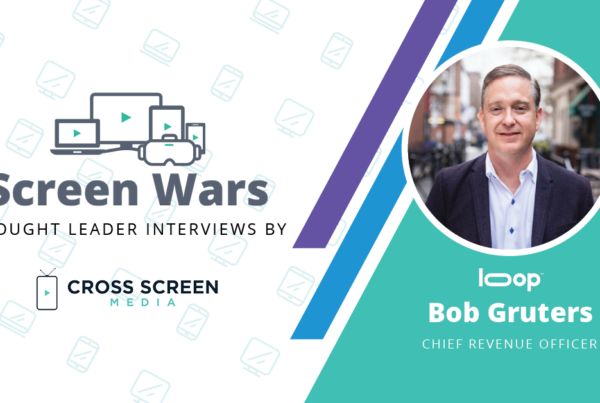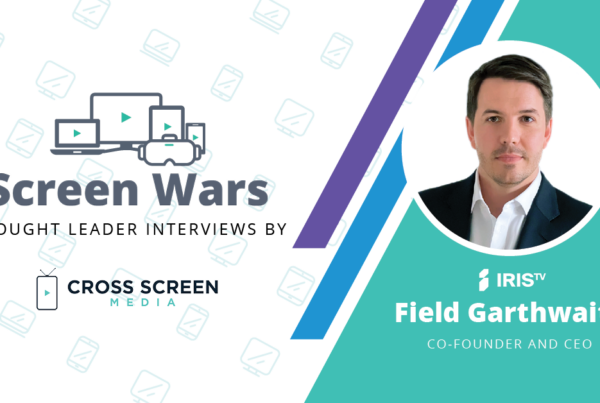Tracey Scheppach, Matter More Media’s CEO, joins Cross Screen Media CEO Michael Beach to share her insights on Addressable TV and how it is reshaping the future of the industry in our latest Screen Wars Thought Leader Interview. Watch the interview here and read the full transcript below.
Michael Beach: Hello and welcome to another edition of Screen Wars. Today, it’s our pleasure to welcome Tracey Scheppach to Screen Wars. Tracey’s a pioneer and true thought leader in the addressable TV space. Tracey currently serves as founder and CEO of Matter More Media. Previous to that, she had held leadership roles in both Publicis and Starcom, just to name a few. So welcome, Tracey.
Tracey Scheppach: Thank you so much for having me.
MB: Absolutely. Well, we’d like to start with an icebreaker for each of our guests. What was your first job, and what lessons did you take away from it that helped you in your career?
TS: You know, I had to go back pretty far for the first job. I think I was eight, and I walked dogs. And I think one of the biggest lessons learned was the power of work. Starting at a young age, I’ve worked since I was eight, always doing jobs. I think it’s essential to have a purpose and a job. I think the biggest lesson I probably took away is trust. So when you’re walking somebody’s prized love of their life, their dog, you take on a lot of responsibility as an eight-year-old. That is probably the one that has stuck with me throughout my career.
MB: That’s great. And how did you get your start in the convergent TV space?
TS: It was actually on a bus coming home from the Olympics and Bondi Beach in Australia, and I met the CEO of a company called Wink. Wink was an interactive TV company, and I was a brand manager before I entered the TV and agency space, so I thought that the idea of interactivity was interesting. But when she told me she collected second-by-second data off of the set-top box, knowing what I knew about media measurement, I said, that’s a game-changer right there! In 2000 I went to work at Wink, and we’ve been trying to release a larger data set to the marketplace for the last 20 years. So that’s what got me hooked.
MB: Love it. Before we jump deeper into the conversation, would you mind giving our community a little bit more background on Matter More Media, and where they sit in the space?
TS: I ran innovation focused on video and a genuine love of TV at Publicis, and for a lot of reasons, I decided to branch out on my own. The needs that I saw in the marketplace were two-fold. There was a need for a consultancy and for activation. Many people are trying to bring addressable technology and data-driven TV to market. Having a buyer’s perspective on many people who are bringing that to market made a lot of sense.
I’m also doing activation, and I’m focusing on a particular type of advertiser, new to TV. I think TV has a lot of potential to bring on a lot more advertisers, and the category that I’m most interested in is taking premium brands out of direct mail and getting them on TV for the first time. I have clients like Williams-Sonoma, West Elm, and Paper Source, and I get inspired by getting my mail every day. But, wouldn’t it be awesome if Restoration Hardware was on TV and did fewer catalog drops?
MB: Absolutely, my background before getting into video advertising was all in direct marketing. So I love that example. The data is just so rich for those companies that it’s just a natural progression.
TS: It is the exact same principle. You’re taking a list and you’re sending, in this case, a catalog to a mailbox. So far, what addressable TV is taking is a list and then sending an asset, which happens to be a 30-second spot to a set-top box. Just replace a mailbox with a set-top box, and replace paper with video. Sight, sound, and motion – they’re really the same principles.
MB: We’re recording this the week after the election, and the big news that everyone’s talking about across the country is surrounding Nielsen’s big announcement today. Do you want to give us a little bit more background on that, and what do you think that means for the industry?
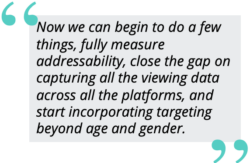 TS: Today is a big day! This is probably the most exciting news we’ve heard in the last decade since C3. What Nielsen has done is expanded its panel to include smart TV and set-top box data. Now we can begin to do a few things, fully measure addressability, close the gap on capturing all the viewing data across all the platforms, and start incorporating targeting beyond age and gender.
TS: Today is a big day! This is probably the most exciting news we’ve heard in the last decade since C3. What Nielsen has done is expanded its panel to include smart TV and set-top box data. Now we can begin to do a few things, fully measure addressability, close the gap on capturing all the viewing data across all the platforms, and start incorporating targeting beyond age and gender.
I believe addressable television was not going to scale without the ability to light up national and linear inventory – that’s what’s been missing. That’s why we were sitting on a fairly large household footprint of around 60 million households but had a very low level of inventory actually enabled all because the MVPDs control it, and they’re two minutes. All in all, it equates to about 3% of linear TV inventory being addressable today.
For this premium product to scale, it needs to be incorporated into the national linear inventory. That is very hard when the currency of C3 is the way inventory is sold today. Taking a whole unit out of sale to light up only 10% of it for addressable doesn’t really make economic sense. We needed a mechanism able to sell what I’m calling the bottom of the avail, or the un-addressable piece, using the traditional currency, and to be accurate, to subtract the portion of the available made addressable. Nielsen’s the only one that can do that, in my opinion, and today they have announced that they have secured the partnerships necessary to make that happen.
MB: Definitely big deal. A few months back, you wrote an ad exchanger column that probably a dozen people sent to me, if not more, on addressable TV. You talked about the issue we have today, where we have about 3% of total impressions being addressable with the potential to go to 50% or more. Knowing Nielsen’s news that we heard today, what do you think that progression looks like? What are the steps going to be in that process?
TS: Measurement is a key step, but I think there is a step before; deployment of technology. Right now, we’re in a phase where we have multiple options that are being brought to the market. We have several options and enablers bringing it to the market through the set-top box, whether that be Canoe using Comcast and Cox and Charter, or whether that be Xandr and potentially all the partners that are lined up with Xandr or Dish. We’re seeing all three of those players in the box, starting to accelerate the technology necessary to light up national inventory.
There are also players on the smart TV side that are doing similar things, not using a box but using the glass and the technology that’s embedded into a smart TV. And so you have stuff like ProjeQtOr, and currently VISEO’s footprint, and Nielsen’s AVA team, who is also lighting up inventory.
So we now have quite a few technical options that I feel comfortable that we will see a major improvement in the technology needed to unlock that inventory. So now it’s possible, right? That was a hurdle we had to get to, and we’ve made a lot of progress in 2020 making sure that that technology is being deployed and the programmers are really leaning in now, even despite COVID,
Once you know that it’s possible, you have to make it technically operational. And that measurement piece was a big gating factor that Nielsen’s announcement, I believe, solves. So it gives us the ability to overwrite a small portion of what was a traditional avail and put a small amount against an actual target, leaving the remainder as mass media as we continue to evolve addressability.
MB: Definitely. Another question at Cross Screen we hear tossed around a lot is the definition of what addressable TV is, growth and impressions, etc. How do you think we should be looking at that?
 TS: I always hate when we have to go back to the definitions, right? But I think it is the ability to reach an actual target on any device within premium TV, in any way the consumer wants to watch it. That last part is significant because many people miss this point, including the ad exchanger folks who show you essentially what they believe the addressable TV marketplace is today and its growth. I think they are missing a big piece of this, and that’s CTV. CTV, and VOD for that matter, were born to be addressable. They were never a broadcast medium. They were always content delivered one at a time when requested. That is what opens up the ability to do addressable TV. To me, addressable TV is way beyond a box on linear, which I think most people define addressable TV as. I believe that is a mistake because it’s bigger than that.
TS: I always hate when we have to go back to the definitions, right? But I think it is the ability to reach an actual target on any device within premium TV, in any way the consumer wants to watch it. That last part is significant because many people miss this point, including the ad exchanger folks who show you essentially what they believe the addressable TV marketplace is today and its growth. I think they are missing a big piece of this, and that’s CTV. CTV, and VOD for that matter, were born to be addressable. They were never a broadcast medium. They were always content delivered one at a time when requested. That is what opens up the ability to do addressable TV. To me, addressable TV is way beyond a box on linear, which I think most people define addressable TV as. I believe that is a mistake because it’s bigger than that.
MB: I think that’s an area you sometimes see lumped together. We use a metric, targeted video. We include data-driven linear as a middle ground occasionally, but this is a much bigger space than just two minutes of an hour of linear that’s considered addressable.
TS: Well, data-driven linear is incredibly important, but to me, it’s a step on the journey, and it’s a great warmup. Going to the buy-side and talking with tons of advertisers, executed with more than 150 advertisers, your discussion starts with, who is your actual target? Depending on who you’re talking to, to the client or within the agency, it’s not women 18 to 49. So once you start to have that conversation about my actual target and measure it differently, which is what data-driven linear is, it’s like the warmup. But it is not until you can eliminate the part of the audience that is less valuable to the advertiser. That doesn’t mean they might not necessarily message them, but they are less valuable. And it’s not until you open that up that you unlock the huge part of the value inherent in addressable TV.
MB: Okay, on the buy side, do you still see siloed video teams, or do you think this is finally going away?
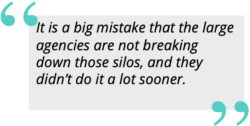 TS: Well, I don’t work at a large agency anymore, so I can’t say from firsthand experience. However, from what I can see, I would say that it is still too siloed. I think it is a big mistake that the large agencies are not breaking down those silos, and they didn’t do it a lot sooner. There is a rich knowledge that TV buyers have, and there is a rich knowledge that digital buyers have. What we’re trying to do is combine the best of both in a unified way. I think there was a lot to learn from each other, and because they were siloed, the marketplaces are developing differently, not necessarily in a good way.
TS: Well, I don’t work at a large agency anymore, so I can’t say from firsthand experience. However, from what I can see, I would say that it is still too siloed. I think it is a big mistake that the large agencies are not breaking down those silos, and they didn’t do it a lot sooner. There is a rich knowledge that TV buyers have, and there is a rich knowledge that digital buyers have. What we’re trying to do is combine the best of both in a unified way. I think there was a lot to learn from each other, and because they were siloed, the marketplaces are developing differently, not necessarily in a good way.
I have taken clients on the digital video side, and I’ll ask them a simple question like, “you’re in a bidding marketplace, what type of CPMs are you paying?” and I hear a number and almost fall out of my chair. And all I can think is “I don’t think your client would be very happy.” You need to call your traditional TV guys. You’re in a less desirable environment paying a significantly higher CPM; you need help.
Those are the types of conversations that are getting missed, at least in some places. And that’s driving many people to go directly to the clients, which may be how it ends, but being a long-time agency person is not my desire. I think agencies have an important role to play, but they’ve got to find a way to bridge that knowledge together.
MB: Yeah. We talked with Dave Morgan from Simulmedia a few weeks back, and he had an interesting point where he spoke about it. We discussed that people with linear experience are starting to retire, and digital people aren’t picking up that skill set. And you’re going to have a gap where linear buying or more traditional buying is still a considerable part of these media plans. But the folks on the digital side aren’t taking the initiative to learn that. I guess that’s something that we see pretty commonly as well.
TS: When you look at the upfront, there’s probably a handful of buyers and a handful of sellers. That’s very different than digital, quite honestly. I was fortunate enough to work and learn from somebody who’s still in the business after 35 years and conducts Google’s upfront. Learning about how deals get done, supply and demand, that information desperately needs to be translated to a larger group of people. At the end of the day, we’re trying to protect premium. I think that’s a big piece of it. The big traditional buyers and sellers know how to protect premium.
MB: Hearing about your example earlier of direct mail people going to addressable made me think of another question. Another area we cover a lot in the newsletter is the digital platforms, the number of unique advertisers is growing. I think Facebook just announced 10 million total advertisers. Obviously, many of those people are extremely long tail. Still, one thought that we have is that addressable TV is going to bring in a lot of new advertisers into the TV premium video space. One, I guess, do you agree with that? And two, how big do you think the pool of potential advertisers for TV could be?
TS: What are we at in TV in terms of, especially national TV, the number of advertisers, 250? 10 million? 250? The answer is somewhere in between there, right? That’s a pretty big range, and I’ve been doing this for over 20 years. Once I started to learn about the technology that was coming forward and the change in distribution, that was one of the first things that I thought was a huge opportunity to bring in more advertisers.
And again, I spend a great deal of my time trying to activate for new to TV advertisers. These clients have substantial marketing budgets, but they’ve never been on television. We can get those, and my target list is at least 30 big ones. For example, J Crew is a target, assuming they don’t go out of business due to COVID adjustments. But, some huge marketers are not on TV. Those seem like really natural fits to me. And then you start getting smaller and smaller and smaller. You can see the trend already starting with Warby Parker or Peloton is one that many people use as an example.
But when you think of those DTC clients, if you could make the price point and the accountability of television, lower the price point and make it more accountable like Facebook, why would you not do this? Everybody knows that sight, sound, and motion is a much better way to create a brand impression, to tell a story, to get people to even convert to a sale. TV has finally got all the tools in place to precisely deliver that, lower the price point for entry, and make it accountable and provable.
MB: Definitely higher level. What’s the most significant change that you’ve seen throughout your career in the convergent TV space? And then what one change are you most excited about moving forward?
TS: When I try and explain what’s happening in TV simply, it is a change in distribution. Early 2005 when I started my job at Publicis, I was trying to educate people that “that” is happening. Whether it’s a change, so that it’s stored onto your DVR, back then TiVo used to be the way we would explain it, or it’s put in a head-end rack and given to you as VOD, or on an iPhone, I was the first to put an ad on a video iPod by the way. And I did some of the early work on iPads. It all comes back to a change in distribution.
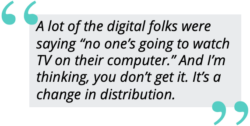 I can remember abc.com was the first to put out full episode inventory. And when the ABC sales guys came in to pitch that, I said “you’re not walking out of the door until I get the packages.” And when I put the offer together for my advertisers as a jump ball, “do you want to participate?” a lot of the digital folks were saying “no one’s going to watch TV on their computer.” And I’m thinking, you don’t get it. It’s a change in distribution. That was the same with Hulu. They started as a web service, and now at least 75% of it is watched on the big screen.
I can remember abc.com was the first to put out full episode inventory. And when the ABC sales guys came in to pitch that, I said “you’re not walking out of the door until I get the packages.” And when I put the offer together for my advertisers as a jump ball, “do you want to participate?” a lot of the digital folks were saying “no one’s going to watch TV on their computer.” And I’m thinking, you don’t get it. It’s a change in distribution. That was the same with Hulu. They started as a web service, and now at least 75% of it is watched on the big screen.
So I think that is what is changing. And there are a lot of things that impacts. Addressability is clearly one of them, measurement is a huge piece. As you change the distribution, you’re going to change in the way things can be counted. And so I think that’s the biggest change that we’re witnessing, and I’ve been witnessing it for the at least last 20 years. I think it’s got still quite a bit to go, to get all the way there.
MB: Great. We can wrap up with one more question, but first I want to highlight a couple of areas on the personal front. First, I definitely recommend our whole community follow you on LinkedIn. I always appreciate how you highlight all of these companies in the space of successes. A lot of times you go on there, it’s just the person promoting their company or anything. And I always learn so much by seeing you, and just get energized as to how much you highlight others’ achievements, obviously along with your own. And second more importantly, you’re the founder and president of game-changing nonprofit. Mind giving our community a little bit background and how they could help?
TS: So January 1st, 2013, my son was diagnosed with leukemia. So I know firsthand what it’s like to hear those four awful words, “your child has cancer.” Right in the beginning of that, I thought, “why don’t we treat this cancer data like the way we treat marketing data?” so it was kind of an aha to me, and set me forth on a passion to try and figure out a solution for that.
At the same time, I knew I needed an outlet, and a friend sent me the words post-traumatic growth, and it really had an impact on me. It’s not just about resilience, it’s not about returning to the same state you were before something tragic happens to your family. It’s about how can you grow from that? So what I decided to do was do the Chicago triathlon. I am not a triathlete, or I wasn’t back then. And so I started to do something hard, and I brought a few friends along with me. And all I did was put a link on my email that said, I’m doing it. I raised $50,000 without asking for money. And it was kind of a light bulb moment, how generous our industry really is.
And so fast forward eight years, I started recruiting people within the agencies and creating an event where we can bring the media folks together to help raise the money and create a social event. Chicago lacks, I think, what New York has in spades, is a lot of social events. So we’ve created that, and so many wonderful people have supported that. We have had 570 athletes, a big chunk of them sourced from all of the agencies. I’ve been so inspired by people leaning in to help us.
The team is called Team Bright Side. You can go to teambrightside.com if you’re interested in doing the Chicago triathlon. Hopefully, it’ll happen next August, last Sunday in August. We welcome anyone to join the team and raise money for what I believe is a great cause. And we’re really proud this year, that we’ve raised $1 million and a half so far.
This year we were able to donate a half $1 million to the University of Chicago, which to my surprise, is the place where the world is working to harness pediatric cancer data, both clinical and genomic data. Just like marketing, just like what I do in addressable TV, we’re trying to help find a more targeted solution for these children because they need it. I’m really proud of that work, and I would love it if anybody wanted to join or donate. I’m not going to stop until we cure cancer, at least in these children.
MB: Love it. What an amazing story. So we’ll definitely post a link, and hats off. That’s an incredible story.
TS: Thank you so much. And my son is doing great.
MB: Excellent. A YouTube star, as we talked about earlier.
TS: Yeah. He’s a YouTube star. He has his Make-A-Wish, he did a collab with Dude Perfect, who happens to be one of the largest YouTube channels. And I think he’s got about 22 million views of that video, which has launched his entrepreneurial adventures.
MB: That’s amazing. All right, we have just one more question that we ask everybody when we wrap up. If you could get people to read one book in the current environment, what would that book be and why?
TS: Well, I can’t just pick one book, sorry. Rishad Tobaccowala’s, I was fortunate to work for Rishad for a very long time. And so I know a lot of his wisdom firsthand, and man, that guy is awesome at the one-liners that really make you think differently. And so I would say, Restoring the Soul of Business is a must-read. So this one you can buy right now for Christmas, for all your friends and family.
I’m really passionate about how we change media to have a more productive civil life. You know, this election has been quite crazy, and I’ve been fortunate enough to work with one of the senior people from the Obama campaigns, Michael Slaby. He’s coming out with a book that I’ve been reading called For All the People: Redeeming the Broken Promises of Modern Media and Information and Reclaiming our Civil Life. So once that comes out, I don’t know exactly when, but I think it’ll help people understand how data and media is used and how we can make sure it’s ultimately used for good.
MB: Yeah, definitely a topic top of everyone’s list right now for sure. Hopefully, that comes out sooner rather than later.
TS: Yeah, exactly.
MB: Excellent. Well, I appreciate the talk, and I’m really grateful for your time. And I’m sure the community is going to love this.
TS: Well, it’s so fun to connect, and I’m wishing you all the best.
MB: Thank you.
See the rest of the Screen Wars Thought Leader Interview series here!
Tracey Scheppach has been a vital architect in building media’s future for more than 20 years – and she’s crafted Matter More Media as a next-generation marketing and media practice focused on video activation. Her advisory services empower marketers to improve how they connect with people, applying the most sophisticated approaches available in the marketplace to simply matter more to the ever increasingly elusive, on-demand consumer.
Her solutions span media, technologies and categories, driving proven innovations across advanced TV, programmatic TV, online video, cross platform video, second-by- second set-top box data, and Smart TV/ACR measurement. She’s evolved the potential of these platforms for some of the largest brands in the world, executing more than 250 campaigns for 50 leading clients including P&G, General Motors, Coke, Bank of America, Samsung and Kraft.
As co-founder and global director of Publicis incubator The Pool, Scheppach and her team gained insights into emerging forms of media and helped create industry standards for new advertising models across six global markets.
Scheppach is a frequent speaker and celebrated leader, recognized by the Advertising Research Foundation Great Mind Award, the Mediaweek 50, Advertising Age Woman to Watch, and the American Advertising Federation Hall of Achievement.
Cross Screen Media is a marketing analytics and software company empowering marketers to plan, activate, and measure Connected TV and audience-driven Linear TV advertising at the local level. Our closed-loop solutions help brands, agencies, and networks succeed in the Convergent TV space. For more information, visit CrossScreenMedia.com.


